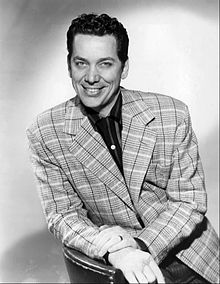NBC Matinee Theater
| NBC Matinee Theater | |
|---|---|
 Host John Conte | |
| Genre | Anthology |
| Directed by | John Drew Barrymore Alan Cooke Walter Grauman Arthur Hiller Lamont Johnson Sherman Marks Lawrence Menkin Albert McCleery Boris Sagal Pace Woods Alan Hanson |
| Presented by | John Conte |
| Country of origin | United States |
| Original language | English |
| No. of seasons | 3 |
| No. of episodes | 650 |
| Production | |
| Executive producer | George Lowther |
| Producers | George Cahan Albert McCleery Frank Price Darrell Ross |
| Running time | 45–48 minutes |
| Original release | |
| Network | NBC |
| Release | October 31, 1955 – June 27, 1958 |
Matinee Theater is an American anthology series that aired on NBC during the Golden Age of Television, from 1955 to 1958. The series, which ran daily in the afternoon, was usually broadcast live and most of the time in color. It was produced by Albert McCleery, Darrell Ross, George Cahan and Frank Price with executive producer George Lowther. McCleery had previously produced the live series Cameo Theatre which introduced to television the concept of theater-in-the-round, TV plays staged with minimal sets.
Jim Buckley of the Pewter Plough Playhouse (Cambria, California) recalled:[1]
When Al McCleery got back to the States, he originated a most ambitious theatrical TV series for NBC called Matinee Theater: to televise five different stage plays per week. This series aired live at 3 p.m. Eastern time and 12 noon Pacific, in order to promote color TV (which NBC parent RCA had just been develope, by having TV and appliance stores be able to show an hour of color television programming while they were open). The program's target audience was the American housewife (one print ad NBC created showed a typical housewife watching the show as) she labored over her ironing. McCleery was the producer. He hired five directors and five art directors. Richard Bennett, one of our first early presidents of the Pewter Plough Corporation, was one of the directors and I was one of the art directors and, as soon as we were through televising one play, we had lunch and then met to plan next week’s show. That was over 50 years ago, and I’m trying to think; I believe the TV art director is (or was) his own set decorator (selecting furnishings and hand props)—yes, of course! It had to be, since one of McCleery’s chief claims to favor with the producers was his elimination of the setting per se and simply decorating the scene with a minimum of props. It took a bit of ingenuity.
The series ended in 1958 due to its high budget; much higher than any other daytime program in television. A few of the later episodes were preserved on color film for later rerun syndication under different titles.

Notable guest stars
- Anna Maria Alberghetti
- Steve Allen
- Mary Astor
- Jim Backus
- Jacques Bergerac
- Richard Boone
- Leo G. Carroll
- Chuck Connors
- Richard Crenna
- Jane Darwell
- Bradford Dillman
- Joanne Dru
- Shelley Fabares
- Frances Farmer
- Nina Foch
- Eva Gabor
- Edmund Gwenn
- June Havoc
- Wendy Hiller
- Dennis Hopper
- Edward Everett Horton
- Vivi Janiss
- David Janssen
- Cecil Kellaway
- DeForest Kelley
- Shirley Knight
- Michael Landon
- Cloris Leachman
- Anita Louise
- Roddy McDowell
- Darren McGavin
- Martin Milner
- Agnes Moorehead
- Rita Moreno
- Jack Nicholson
- Hugh O'Brian
- Margaret O'Brien
- Arthur O'Connell
- Maureen O'Sullivan
- Susan Oliver
- Geraldine Page
- Suzanne Pleshette
- Mala Powers
- Barbara Rush
- George Peppard
- Vincent Price
- Cesar Romero
- Marian Seldes
- Dean Stockwell
- Phyllis Thaxter
- Marshall Thompson
- Rudy Vallee
- Ethel Waters
- James Whitmore
- Mary Wickes
- Fay Wray
- Alan Young
Award nominations
| Year | Result | Award | Category | Notes |
|---|---|---|---|---|
| 1956 | Won | Emmy Award | Best Contributing to Daytime Programming[2] | |
| 1957 | Won | Golden Globe Award | Best TV Show | Tied with The Mickey Mouse Club, Cheyenne, Playhouse 90, and This Is Your Life |
Notable episodes
One noteworthy episode is "Dracula", which first aired on 6 January 1956, and was repeated on 23 November 1956. This was based on Bram Stoker's book, similar to the 1931 movie Dracula. It was adapted by Robert Esson and directed by Lamont Johnson. Shown in color, the episode had John Carradine as Dracula and Lisa Daniels as Lucy Weston. This was the first time "Dracula" had been presented on television and the first time it had been done in color.[citation needed]
References
- ^ Buckley, Jim. "Prelude to Playtime," Pewter Plough Playhouse Newsletter, Vol. 2, No. 2, March/April 2006.
- ^ "Matinee Theatre". Academy of Television Arts & Sciences. Retrieved 2015-07-01.
External links
- Matinee Theatre at IMDb
- Template:Tv.com show
- Matinee Theatre at CVTA with episode list
